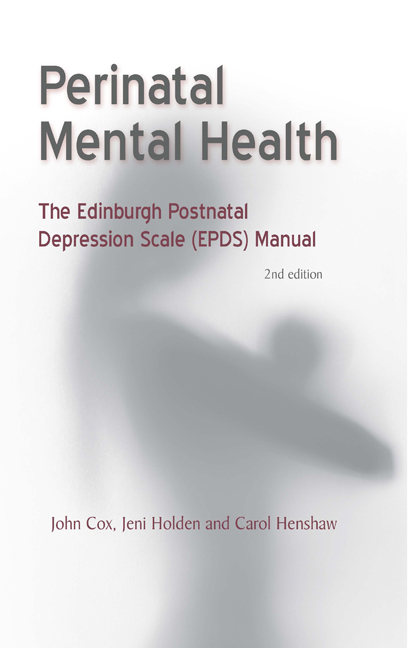Book contents
- Frontmatter
- Contents
- The authors
- Acknowledgments
- Abbreviations
- List of figures
- Foreword
- Preface to the first edition
- Preface to the second edition
- 1 Postnatal depression: an overview
- 2 The origins and development of the Edinburgh Postnatal Depression Scale
- 3 International and cross-cultural issues
- 4 Using the Edinburgh Postnatal Depression Scale in clinical settings: research evidence
- 5 Humanistic and person-centred interventions in perinatal depression
- 6 Screening and intervention services in the community
- 7 Using the Edinburgh Postnatal Depression Scale
- Appendix 1 The Edinburgh Postnatal Depression Scale
- Appendix 2 Translations of the Edinburgh Postnatal Depression Scale
- References
- Index
2 - The origins and development of the Edinburgh Postnatal Depression Scale
- Frontmatter
- Contents
- The authors
- Acknowledgments
- Abbreviations
- List of figures
- Foreword
- Preface to the first edition
- Preface to the second edition
- 1 Postnatal depression: an overview
- 2 The origins and development of the Edinburgh Postnatal Depression Scale
- 3 International and cross-cultural issues
- 4 Using the Edinburgh Postnatal Depression Scale in clinical settings: research evidence
- 5 Humanistic and person-centred interventions in perinatal depression
- 6 Screening and intervention services in the community
- 7 Using the Edinburgh Postnatal Depression Scale
- Appendix 1 The Edinburgh Postnatal Depression Scale
- Appendix 2 Translations of the Edinburgh Postnatal Depression Scale
- References
- Index
Summary
Origins of the EPDS
In the early 1980s, the limitations of existing self-report questionnaires for use in community samples were beginning to be recognised. Philip Snaith (1983), for example, had acknowledged the need to modify existing scales for use in specialist settings; and Channi Kumar (1982), in Motherhood and Mental Illness, recognised there was a need for
‘… some form of simple self-administered scale … for use in antenatal and postnatal settings, to pick out potential cases of women with depression and anxiety. Existing questionnaires contain questions which are dissonant with the woman's pregnant or parturient state and, on the other hand, questions about her mental state, which take account of her condition, are lacking.’ (p. 112)
In Edinburgh at that time the serious limitations of existing self-report scales had become very apparent to us. Although we used the best available scale in our prospective study (Cox, 1983) – the Anxiety and Depression Questionnaire (SAD) of Bedford & Foulds (1978) – and although it had the advantage of brevity and few somatic items, it failed to detect any increase in these symptoms in the first postpartum weeks, and the recommended cut-off score was completely inappropriate for use during pregnancy (Cox, 1983). Of the 13 pregnant women with a score of 6+, only 3 had any form of mental disorder, and some items lacked face validity for childbearing women. We concluded:
‘If these difficulties with the SAD are replicated by others using different self-report questionnaires, then the implications for the reliable detection of neuroses in childbearing women are considerable. It might for example be necessary to re-design or re-validate self-report scales specifically for use during pregnancy and again for use in the puerperium.’ (p. 6)
The intent of the grant application to the Scottish Home and Health Department in 1983 was therefore to develop and validate a screening scale specifically for use with childbearing women in the community, and also to carry out an intervention study by health visitors.
- Type
- Chapter
- Information
- Perinatal Mental HealthThe EPDS Manual, pp. 17 - 26Publisher: Royal College of PsychiatristsPrint publication year: 2014



